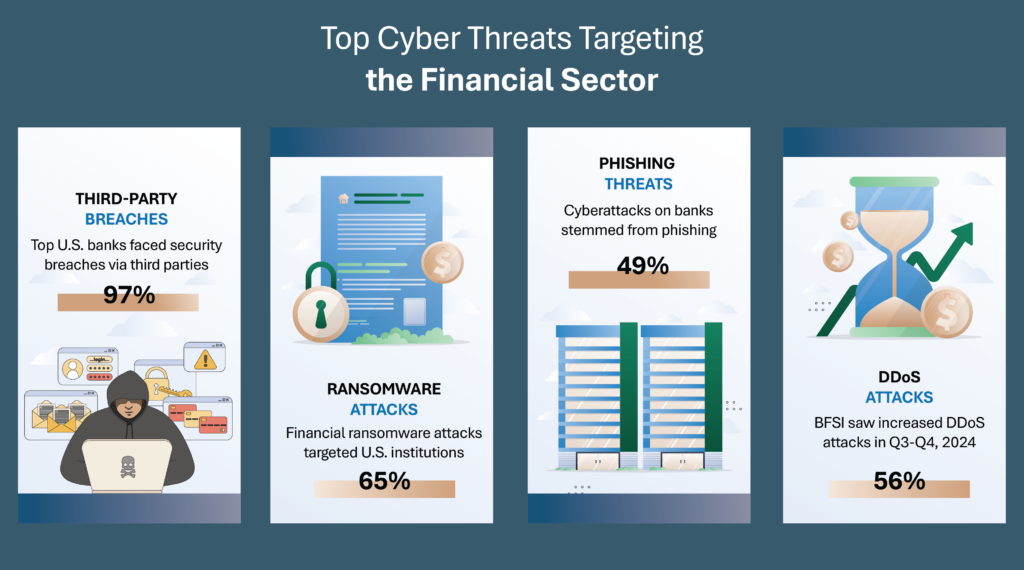What Cyber Threat Intelligence Means for Banks and Financial Institutions in 2025
Every day, financial institutions are under siege from a growing range of cyber threats. What’s once considered a niche concern is now front-and-center, as cybercriminals recognize the massive financial rewards that banks and financial services offer.
As per Security Scorcard’s report, 97% of the largest U.S. banks reported third-party breaches
The problem? The volume of threats is growing exponentially, and security teams are struggling to keep pace. That’s where cyber threat intelligence comes in. Banks need more than just basic protection; they need actionable insights that allow them to spot threats before they cause real harm.
But visibility isn’t enough. Banks must know what to do with the intelligence they have, how to prioritize it, and most importantly, how to use it to safeguard their operations.
Let’s explore why the financial sector is such a prime target and how cyber threat intelligence can be the game-changer in keeping banks one step ahead of cybercriminals.
Why Are Banks and Financial Institutions Constantly Targeted?
1. High Financial Rewards
Cybercriminals are in it for the money.
– Banks store immense amounts of wealth, not just in cash but also in sensitive financial data.
– Successful attacks can lead to multi-million-dollar ransoms, massive fraud, and data theft. For criminals, a breach in the financial sector often means a windfall of enormous proportions.
2. The Value of Sensitive Data
Banks hold invaluable personal and financial information; everything from security numbers to credit card details.
– If hackers manage to breach that vault, the consequences are severe.
– Identity theft, fraudulent transactions, and lawsuits can quickly follow, making financial institutions a prime target.
3. Systemic Importance Makes Them a Strategic Target
Banking systems don’t just affect the institutions themselves; they are the backbone of entire economies.
– Nation-state actors and politically motivated hackers target these systems to disrupt financial stability, spy on transactions, or even destabilize a country’s financial infrastructure.
– The financial sector is essential to national security, making it an ideal target for these high-stakes operations.
4. Expanded Attack Surfaces with Digital Transformation
As more financial services move online and into the cloud, they have increased their exposure to cyber threats.
– While these advancements offer great benefits- better customer experience and more efficient services; they also open new opportunities for attackers.
– With more third-party integrations and cloud services, there are more ways for cybercriminals to exploit vulnerabilities.
There are clear reasons why financial institutions are constantly in the crosshairs of cybercriminals: the high rewards, the valuable data, the systemic importance, and the growing digital footprints.
As threats evolve, so must financial institutions’ security strategies. Proactive cyber threat intelligence is the key to staying ahead of these risks.
Top Cyber Threats Targeting the Financial Sector
Financial services face a slew of cyber threats, each with its own specific impact on security, operations, and reputation.
Let’s dive into some of the most pressing dangers:
1. Ransomware
It’s not just about locking up data anymore, today’s cybercriminals are also threatening to leak sensitive information unless a ransom is paid. Trustwave’s report reveals that 65% of ransomware attacks targeting financial services were in the US.
This “double extortion” tactic has made ransomware even more dangerous, as attackers now have more leverage to force payments.
2. Phishing & Social Engineering
According to Trustwave research, phishing was the source of 49% of attacks against financial institutions.
Hackers use everything from fake websites to deepfake audio to trick bank employees and customers into revealing personal information.
Even multi-factor authentication isn’t foolproof anymore; hackers are evolving their techniques to bypass these safeguards.
3. Banking Trojans & Malware
Malware that targets banking systems can silently infiltrate a bank’s operations, intercept transactions, steal credentials, and even manipulate systems.
4. DDoS Attacks
Distributed denial-of-service attacks have become more common, with attackers using them to overwhelm banking systems, disrupting everything from online banking platforms to ATM services.
These attacks are typically designed to cause financial disruption or simply to gain political leverage.
5. Insider Threats
Not all threats come from the outside. Insiders, whether malicious or simply careless, pose a huge risk to financial institutions.
Compromised insiders can inadvertently or intentionally leak sensitive data or cause internal damage that’s just as severe as an external attack.
6. Third-Party and Supply Chain Vulnerabilities
The interconnected nature of modern banking systems means that third-party providers play a big role in security.
Unfortunately, this reliance also introduces vulnerabilities. Cybercriminals exploit weaknesses in vendor systems, allowing them to infiltrate financial institutions without ever breaching the bank’s defenses directly.
7. AI and Quantum Risks
As technology evolves, so do the threats. The rise of AI-powered cyberattacks is making attacks faster and harder to detect.
At the same time, quantum computing could soon break existing encryption methods, rendering many of today’s security measures obsolete.
Financial institutions need to keep an eye on these emerging risks through cyber threat intelligence to prepare for the future.

How Cyber Threat Intelligence Helps Financial Institutions Stay Ahead
1. Real-Time Threat Visibility & Faster Response
Banks are dealing with fast-moving threats. Whether it’s a DDoS attack or a ransomware campaign, responding quickly is crucial.
High-quality cyber threat intelligence gives financial institutions the visibility they need to detect and address threats in real-time, minimizing potential damage.
2. Fraud Prevention
CTI doesn’t just catch attacks after they happen, it helps banks stop fraud before it starts. By monitoring dark web marketplaces and using tools like honeypots, banks can intercept stolen data before cybercriminals even have a chance to use it.
3. Protecting Against Phishing & Social Engineering
CTI can identify phishing campaigns early, enabling banks to neutralize fraudulent domains and protect their customers. Additionally, by recognizing patterns in social engineering attacks, banks can train employees and deploy countermeasures to reduce the risk of successful exploitation.
4. Making Smarter Security Decisions
With CTI, banks aren’t left to guess when it comes to security decisions. Machine-readable intelligence helps security teams prioritize threats based on their risk level, so they can focus on what really matters.
From CISOs to analysts, everyone can make informed decisions to enhance overall security posture.
It provides the threat intelligence needed to thwart attacks, stop fraud, and keep critical systems safe. In an industry where every second counts, CTI is a vital tool in the battle against cybercrime.
Winning the Cybersecurity Race Before the First Blow with CTI
The financial sector faces a daunting array of cyber threats, and the consequences of a breach are severe. But with the right CTI, financial institutions can shift from a reactive to a proactive defense strategy.
By staying one step ahead of cybercriminals, banks can protect their assets, their customers, and their reputation in an increasingly hostile digital landscape.
Financial institutions must embrace CTI and continuous monitoring to remain resilient against ever-evolving threats. It’s not just about defense; it’s about winning the war on cybercrime.
Outsmart Attackers with Our Defense Strategies
Network Intelligence recognizes that financial institutions are confronted with some of the most intricate and dynamic cybersecurity risks. We give your company the capacity to proactively detect and reduce hazards before they become serious attacks by utilizing CTI.
Our customized CTI solutions provide essential insight into insider dangers in addition to helping you detect external threats, guaranteeing thorough network safety.
We keep an eye on real-time data, identifying new attack trends and using AI-powered insights to predict cybercriminals’ strategies.
Get in touch with us to find out how our CTI solutions can help you protect your digital assets.
Author
-

Richa Arya is the Senior Executive Content Marketer and Writer at Network Intelligence with over 5 years of experience in content writing best practices, content marketing, and SEO strategies. She crafts compelling results-driven narratives that align with business goals and engage audiences while driving traffic and boosting brand visibility. Her expertise lies in blending creativity with data-driven insights to develop content that resonates and converts.
View all posts
